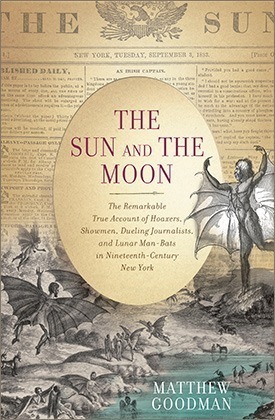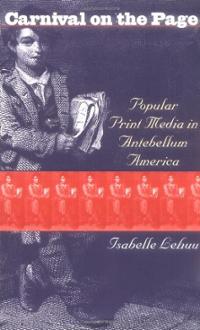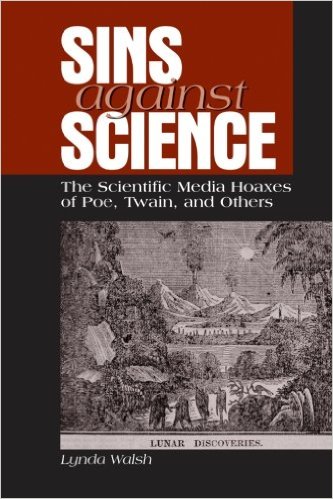This literary and print culture is one of the longer subsections and for means of brevity, sanity, and any semblance of understanding I have cut it close to half (8/7) in order to try and make sense of it.

One of my favorite books, and, incidentally, one of the most recent published in this menagerie is Matthew Goodman’s The Sun and the Moon: The Remarkable True Account of Hoaxes, Showmen, Dueling, Journalist and Lunar Man-Bats. The books over-arching cohesion comes in the form of the “Moon hoax” printed in the New York Sun newspaper in 1835. The rest of the subtitle is spread throughout the book with enough force that a hard-nosed editor would have required Goodman to make this three different books.
Other than struggling with competing narrative syndrome, the book is an excellent collection of newspaper and cultural American History in the 1830s. The main theme of the Moon Hoax is te discovery of living beings on the moon, reported as matter of fact in the same style as the scientific articles, in fact it was said to be reprinted from a science journal. that were gaining popularity with the new readers of the penny press.
Since Locke’s Moon story for the Sun was similar to one of Poe’s stories (Hans Pfaal) Poe remains a secondary character with a large footprint for the rest of the book. He serves as a kind of pivot point to look at other hoaxing (diddling) during the period from his exposing a chess playing automaton which was connected to Barnum enough for a Barnum chapter and the slave who was supposed to be a nurse of a young George Washington. You can see why it was easy to get carried away outside the moon hoax proper.
The rest of this is just a mess of literary criticism, scholars talking across one another to establish methodologies to “save” novels from obscurity, or to argued against the structured canon of distinctly “American” Literature. It really doesn’t matter where we start there will be some broad brushing from here on.

The Lay of the Land: Metaphor as Experience and History in American Life and Letters can be wholly summed up as a discussion of works in which nature is described, regarded, treated, vilified, etc as feminine. The box that Annette Kolodny is unpacking (in 1975) is the idea that to talk about land as being both motherly sustaining and virgin to be taken leads to some great cognitive dissonance within the rhetoric of nearly anything in print. Land as both mother and mistress is something that, according to Kolodny, leads to the destruction of the environment as the frontier gradually disappeared. The destruction was ultimately the result of frustration and disillusionment. Freud would be proud.
As I understand it this is one of the earliest attempts are drawing tools across disciplines, in this case psycho-linguisitics, cultural history, literary history, and the analysis of symbols, to understand and possibly recreate how certain instances of the past influenced certain ways of thinking, describing, or writing. She claims that it would raise more questions than it provided answers (it does) and that is should start a conversation which I *think* is part of the impetus for some of the books that follow.

Beneath the American Renaissance is where I realized that I might be floundering more than a little out of my element, not being a trained student in American Literature. This was my first foray into the American Renaissance both as an idea and as a place in time. I understand the connotations (similar to the Harlem Renaissance a century later), but I can’t help but get hung up on the idea that there was nothing in the pre-colonial period close to this level of “pure cultural development” that could be “reborn” in the early 19th century. In that case it is more of an American naissance than anything resembling a re.
That being said the idea (and subtitle) that it was The Subversive Imagination in the Age of Emerson and Melville promises a way to understand what makes American literature distinctly American. The book exists to expand (get beneath) ye olde F.O. Mathiesson’s American Renaissance. Reynolds work challenges the idea that the (now famous) American authors were not “marginal figures in a society that offered few literary materials.” This established notion rests on the idea of what constituted “literary materials.”
Buried within Reynolds’ genre collecting and labeling is the most useful parts of the book. The connections between “high” American authors–Emerson, Thoreau, Hawthorn, Poe, Melville, Whitman, Dickinson–and the “low” popular literature are exactly what made them the standard syllabi for Am. Lit now. Far from being “ahead of their time” or “above the flow” each of these authors gleaned much (in content and even style) from the popular literature including sentimental fiction, sensational novels, reform tracts with “anonymous” authors, penny papers (which included trial reports), and dark humor.

Whereas Reynolds wants to expand Matthiesson’s pantheon, Jane Tompkins’ Sensational Designs: The Cultural Work of American Fiction wishes to deconstruct it completely. She says as much near the end: “this present study and Mattheissen’s are competing attempts to constitute American Literature” (200). This is in the final chapter entitled “But is it any good?” the question that dogs the inclusion of some of the popular works that Tompkins highlights including Wieland, Arthur Mervyn, and the standard-bearer Last of the Mohicans. This becomes and argument (with Matthiesson, I think) over the canon of American Literature. She even has a chapter called “The Other American Renaissance.” What the book mostly covers is the work of Susan Warner compared to Hawthorne. Hawthorne was aided by “circumstances” and Warner was hindered by (literally) not being Hawthorn. Partly I believe Tompkin’s is right, may of these works need to be brought in and studied as canonical, or at least historical works within antebellum American, just as Reynolds suggests with his inclusion of Poe and Dickinson on Matthiesson’s pantheon, there is room for Tompkin’s inclusions, but (and I think this is probably due to it being the 80s) she seems to think that there are only a set number of spaces and some of Matthiesson’s hallmarks need to be removed before Warner can taker her place. Taken together, instead of one of the other, these three works–Matthiesson from 1941, Tompkins, 1986, and Reynolds in 1988–can serve to get a much more holistic picture of early 19th century American literature.

Some of that dark humor and popular fiction comes to the front in Isabelle Lehuu’s Carnival on the Page: Popular Print Media in Antebellum American. This book did not go in any direction that I had figured. Lehuu’s model from literary criticism (Mikhail Bakhtim) and Anthropology (Victor Turner’s liminality work) make for a less than charming odd couple. The idea that the carnival atmosphere from open markets and feasts in the middle ages is reinvented in the fiction of Antebellum America. The book itself is a carnival of sorts looking at a vast sample of Antebellum print materials including those penny newspapers mentioned above, illustrated ladies magazines, giant newspapers and giftbooks.
Lehuu’s position is that these publications significantly changed the cultural landscape of America by challenging the definition of what constituted a “book.” American literature could be shaped (and was according to Lehuu) by printed artifacts that were “cheap, light, and grotesque.” These may have led to a “rupture” in print culture that separated the Antebellum period from its past and its present. This perspective depends on the idea that Antebellum literature looked a lot like it is taught to sophomores–that is expensive, homogenous, and serious. As we’ve seen in the other cases not only is that not true, but it was many of the light, cheap, and grotesque sources that fed the “greats” that are taught as cementing Antebellum literature as expensive, homogenous, and serious. She also lumps penny press papers into the same genre as yellow journalism, which I find extremely problematic.

Sam Halliday’s Science and Technology in the Age of Hawthorne, Melville, Twain, and James: Thinking and Writing Electricity swerves a little more into the science lane. Sort of. The book looks at the literary appropriated of science and technology vocabulary, in this case electricity. This is a continued list of examples where electricity is either a thing to be written about or described, a thing used to describe, or varying operations of bother. The “spark” and various other electrical subtexts serve as model, metaphor, or substance for ideas. Electric communications led to new ways of miscommunication and misrepresentation (think of the modern equivalent being the impossibility of read tone or mood in text messages and spam emails). It also brought people across a growing nation together and allowed for the alienation of these nearby. It was these social constructs and cultural changes that lead to not only the “low” accounts of the popular press expressing worry or more often cynicism, to the more lofty accounts of the age by those mentioned in the books title. It was things like electricity and the telegraph and others that influenced both thinking and writing. An interested note, one of the reviews for this book that I read mentioned early on that Halliday’s study was “grounded in scientific and technological developments.” I would like to think that this is another example of electrical metaphor (of course it could just mean that Halliday’s head isn’t in the clouds, but I will give the reviewer the benefit of appreciating the imagery). It also reminds me of one of the more popular Schoolhouse Rock videos that compares your nervous system to a telegraph line:
Sins Against Science is an attempt to analyze the text and reader response to (subtitle) The Scientific Media Hoaxes of Poe, Twain, and Others. There are pieces of this book that are phenomenal. There are other pieces of this book that show a newly developed methodology for literature and reader analysis on historical texts in a way to make it quantifiable. That isn’t the benefit of the book.

The useful parts of the book help you understand why the people might have believed media hoaxes. She uses a couple of examples byTwain, a few from Poe, and old Twain employer and colleague Dan DeQuille (William Wright). The notion that these hoaxes were presented in the same manner as actual factual texts is the broadest basis for understanding why people could be taken it. Most were attempts to show the public that their unquestioning faith in the science bug could have dire consequences. In these instances the morals are more along the lines of “in this case, you just look foolish, but you could have lost money, life or limb in other instances.” Other times it was just Twain being annoyed with the latest scientific “fads”–fossils in the case of his “Petrified Man” stories or Poe’s annoyance at the public funding of science at the expense of the arts.
Poe was trained in science in Philadelphia, and Dan DeQuille had been a miner before becoming a journalist. These instances were not only instances of “copying” science writing, both had been science writers at some time during their careers. The problem for historians using this book is that when you jump over all the “I’ve harnessed SPSS to study the humanities” (that is unfairly critical I know) you are left with interesting instances that could easily be tied together for a better understanding of how they managed to continue to be successful (or not) in the face of contrary facts. At best it is a proof of concept for Lynda Walsh’s approach to understanding historical readerships. At worst it is a disassociated set of essays with some interesting asides into print culture. Where she mentions Lyell’s work in a quasi-asside it is evident that she has either never read Rudwick, or did not take what he said to heart, or where Lyell’s work sat within the circles of the English Geologist (as conservative and falling back on the old “theories of the earth” stance). There are other glaring omissions as well. In a book about Media hoaxes by Poe one would expect an analysis of his work on diddling. If you can manage to wade through the over abundance of theorectical vocabulary and situational ists and isms in the beginning the individual chapters may serve as a start towards a better understanding of the cultural association of hoaxes within American society as a whole, and not just historically. It is just going to take someone besides Walsh to make that happen. Walsh ends the book the the 1996 Sokal Hoax wherein a paper “liberally sprinkled with nonsense” appeared in a postmodern cultural studies journal in an attempt to show that it was the postmodernists (specifically, but maybe not entirely, the cultural studies folks) were the real sinners against science.

Nina Baym’s book would be better suited if the title and the subtitle were switched: American Women of Letters and the Nineteenth Century Sciences: Styles of Affiliation. It is the affiliations that drive the book to uncover the ways in which women writers responded to the sciences. Women did not challenge the premises of the sciences and later its developing professionalization or that it was a male-dominated institution. The affiliations here are between the middle class woman and science. From science women (and I suppose more broadly Woman) could gain connections to reason, progress and modernity. On the other hand, women could provide science with popularizers, appreciators, and (more importantly) consumers. Nature writing, ladies magazines, and education promotion were just some of the topics that women of letters were publishing. Botany as we’ve seen in the earlier posts again rules supreme in the eye of these appreciators. Botany was hailed as the perfect hobby for a middle class wife living in the country in order to stave off boredom. Beyond the cadre of women popularizers Baym looks at the wives of men of note who were generating scientific knowledge. Either as illustrator or, in the case of Elizabeth Cary Agassiz, her husband’s “ghostwriter and publicist.” More than just bringing women out of obscurity Baym’s work provides a more complete image of the scientific writings that Walsh deemed so common to the laypeople on either side of the 1840s. In the end it provides readers with, among other catalogue lists, the outline for the strategies middle class women of letters used to associate themselves with science as well as the limitations of the same affiliations.

